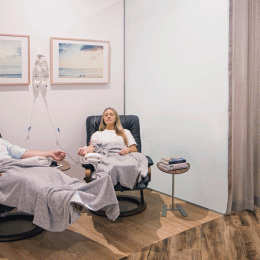There is an emerging opportunity to use workplace design to promote a holistic state of wellbeing for your team – not just the clients who seek your services.
An estimated average 54 percent of waking hours are spent at work (Sodexo, Workplace Trends 2014).
The role of workplace design is shifting from a “space-centric” to a “people-centric” approach in workplace design.
When employers provide work environments that support user control, natural elements and daylight, and changing postures, they address the physical and psychological health of people, enhancing engagement, creativity, innovation, and retention. This leads to business success.
Wellness programs have long been in place, encouraging physical (healthy choices in eating, exercise, etc.) and psychological health in employees.
Separate from wellness programs, sustainability initiatives have addressed physical health by minimising exposure risks to harmful chemicals and materials through standards such as LEED certification.
Ergonomic standards have been developed to reduce risk of musculoskeletal injuries in office workers.
However, these disparate programs fail to address a complete sense of the whole person at work that includes both physical and mental health, while encompassing performance, engagement, and wellbeing.
Productivity used to be the ultimate goal for earlier generations of office workers whose mentality around work was to bring the “work only” version of themselves into the office.
The “whole person” was not really considered in space design in the past. Instead, the focus was on functional requirements that support the work persona: tasks, technology, and processes.
Traditional space-centric design are created directly for the best interests of the employer by driving employee performance.
People-centric design puts people at the centre of the design process, with outcomes related to quality of life (such as reduced stress). But traditional business issues, such as engagement and performance, are also positively affected.
Numerous factors increase stress levels: Lack of control over work process and work space, enclosed and poorly lit spaces, plus noise and interruptions in concentration are some key contributors.
Some ways to address this in the workplace include increasing the availability of user control over the workspace.
SEE THE LIGHT
One of the fundamental roles of lighting is to allow people to see and execute a task in a safe and comfortable manner. It allows for working without causing fatigue, headaches or eye strain. Light affects how people perceive and appreciate a space, its interior and its occupants.
Depending on what the activity requires, lighting can be used to create spaces that appear more bright and open, or more intimate and cozy.
Light also has a powerful impact on the mind and body, affecting circadian rhythms and hormonal activity, which ultimately affect quality of sleep, energy, mood, and productivity.
Try to incorporate more natural light into the overall office environment. Install flexible task lighting so that the individual can control brightness and position of the lighting source.
KEEP IT FLEXIBLE
Ensure workplace flexibility through adjustable furnishings, such as seating, adjustable height work surfaces, shelving, and display. Create a variety of individual, group, and social interaction spaces that let employees choose the workspace size, type, furnishings, and technology that fit their immediate work needs.
BACK TO NATURE
Introduce elements of nature into the workspace. The concept of biophilia suggests that humans have a biological need to connect with nature on physical, mental, and social levels, which can affect personal wellbeing, productivity, and societal relationships.
Those who work in environments that incorporate elements of the natural environment, such as daylight and views outside, report a 15 percent higher level of wellbeing than those who work in environments devoid of nature.
Simply adding plants in the workplace can have a profound effect on the improvement of mental health at work, not to mention improving indoor air quality and alleviating respiratory issues.
Design using natural materials and patterns that evoke nature can also play a powerful role.
SOUNDS GOOD
Research shows that sounds from nature, such as birdsong or rippling water, promote faster recovery from stressful tasks compared with traffic and ambient building noise, such as air- conditioning equipment.
Additional research suggests that using pleasant sounds from natural environments to mask background workplace noise could decrease employee stress and increase worker productivity.
Reduce noise distractions. Refrain from creating areas that generate noise (eg, hands-free speaker phones) in the midst of areas where people need to concentrate.
Educate the team by communicating policies and design choices that foster consideration among colleagues. This helps them understand expectations for what type of work and noise is appropriate in differing workspaces and how to control noise distractions for themselves and others.
KEEP IT MOVING
As well as height-adjustable as well as otherwise ergonomically correct salon furniture for both therapists and clients, design and furnish lounge spaces to facilitate safe postures.
Select lounge furniture with firm seat and back cushions in the waiting area and in staff relaxation areas.
REDUCE HEALTH RISKS
The materials of the physical building itself (eg. asbestos-free, low VOC levels), the interior design (eg. sound absorbing surfaces, natural lighting at workstations), and the HVAC system (eg. air quality), are a few ways in which the physical elements of the building can impact wellbeing. To reduce risks:
- Minimise pollutants in the air, water and food. Use international standards (e.g., LEED, BREAM, LBC) as guidelines.
- Implement filtration and monitoring systems for air and water. • Specify only “healthy” materials on furnishings.
- Review and eliminate harmful cleaning chemicals.
THE POWER WITHIN
When wellbeing is “built in” to the design of space it can be very effective. With corporate-wide health policies and wellness programs, employees need to “opt in” to actively participate and enjoy the benefits.
Unfortunately, research shows an average of only 25 percent participation in US wellness programs.
When wellbeing principles are factored into design, people are surrounded by it while they work within the space, making it impossible not to participate and receive the benefits of better psychological and physical health.




